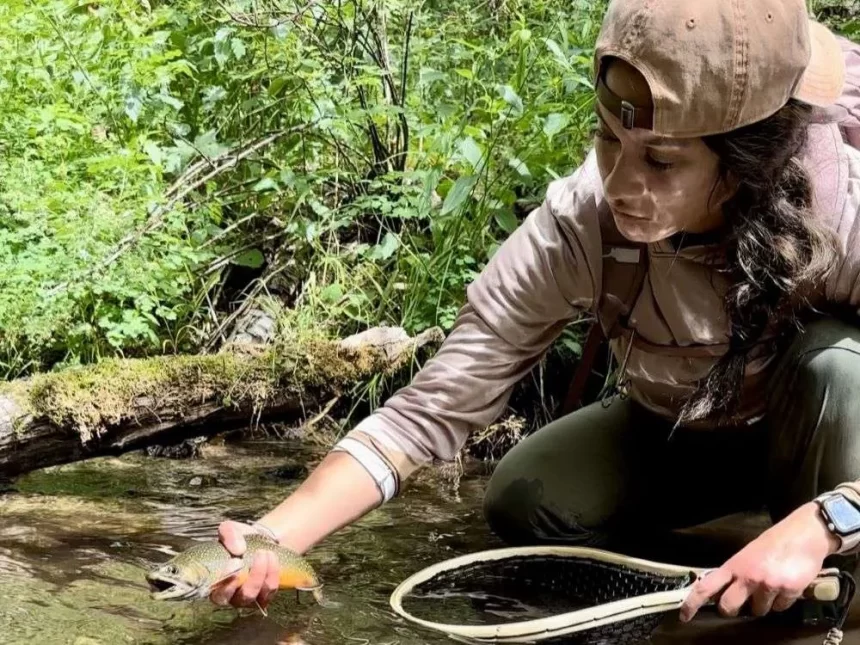By Craig Springer, USFWS
September 28 marks the 52nd National Hunting and Fishing Day, an annual event first proclaimed by President Nixon in 1972. Hunting and fishing and target shooting were then, and remain, lifestyle choices enjoyed by millions of Americans from all walks of life on every rung of the economic ladder.
The reasons for fishing and hunting and target shooting vary, but irreducibly, a spiritual matter lies at the kernel.
And all things spiritual have an upward movement: squirrel hunters scan the autumn hardwoods for bushytails deftly leaping branch to branch; a cutthroat trout darts off a cobbled high-country creek bottom to take an Elk Hair Caddis off the silvery surface; a pair of ruffed grouse gain airspace through a leafy lane in front of a rock-stiff German Shorthaired Pointer; florescent-orange black-rimmed clays lift out of the trap house on “pull,” arcing away from of the shooter who shoulders a 12-gauge; waterfowl hunters endure cold wet mornings in the blind, eyes turned upward perusing early winter’s sooty gray skies.
There is no dichotomy between people and nature. It is nature that makes us human and our immersions as participants rather than mere observers prove this out. These outdoor pursuits draw us nearer to nature and get us in touch with our own selves—a primal connection that brings us as close to Eden as possible.
Thinkers and creative types have speculated on the matter since time immemorial. Bet you have too.
Plato in 345 BCE contemplated nature and ethics through dialogs in The Laws. “The fisherman shall be allowed to hunt in all waters except havens and sacred rivers and pools and lakes, but only on condition that he makes no use of muddying juices,” referring to rendered mullein seeds that stupefy fish.
Madonna, the Material Girl, explicated to the BBC her views on food procurement. “When you’re shooting, you are standing in the forest for really long periods of time, so you end up looking at the leaves and the sky and the trees and you have a lot of time to meditate. You have more of a respect for the things you eat when you go through, or see, the process of killing them. I wear leather shoes, I eat fish, I eat chicken and I eat game. I like knowing what I’m eating and knowing the process.”
Writer-philosopher Jose Ortega y Gasset posited on the excellent, the elegant, and the elixir to be found in outdoor pursuits. “Life is a terrible conflict, a grandiose and atrocious confluence. Hunting submerges man deliberately in that formidable mystery and therefore contains something of religious rite and emotion in which homage is paid to what is divine, transcendent, and in the laws of Nature.”
Two conservation laws reside on the same contour: Pittman-Robertson and Dingell-Johnson, also known as Wildlife Restoration and Sport Fish Restoration. Federal excises taxes paid by the manufacturers of firearms, ammunition, archery gear, fishing tackle and motorboat fuel ensure that reliable and consistent funding exists for state fish and wildlife agencies to properly manage fish and wildlife resources and ensure public access to fish and hunt and safely target shoot on modern ranges.
As an economist might say, the demand exists. The 2022 National Survey of Fishing, Hunting, and Wildlife-Associated Recreation shepherded by two U.S. Fish and Wildlife Service economists, Richard Aiken and Jerry Leonard, reveals that 47 million people target shoot and 19 million enjoy archery. As for fishing and hunting, 39.9 million anglers made 463 million trips, fishing 785 million days. Similarly, 14.4 million hunters made 165 million trips, hunting 241 million days. They spent a combined $144.6 billion to fish and hunt.
Economists Aiken and Leonard waded chest-deep further into the economic and demographic data to ferret out more useful information. They have recently published addendum reports (with more to come) on wildlife watching; participation by minorities; and retention, recruitment and reactivation of anglers and hunters, the latter of which reveals that unrealized opportunities exist to welcome adults into hunting and fishing.
Author Walt Harrington was one such adult-onset hunter. He was introduced to rabbit hunting, marrying into an African American family who ritually sought Kentucky cottontails each autumn. Harrington wrote in The Everlasting Stream, “Only after I began hunting was I hit with the shock that something deep inside me gets excited when the prey appears, when the dogs howl, and that maybe I’m not that different from those dogs, that I must work at being human.”

